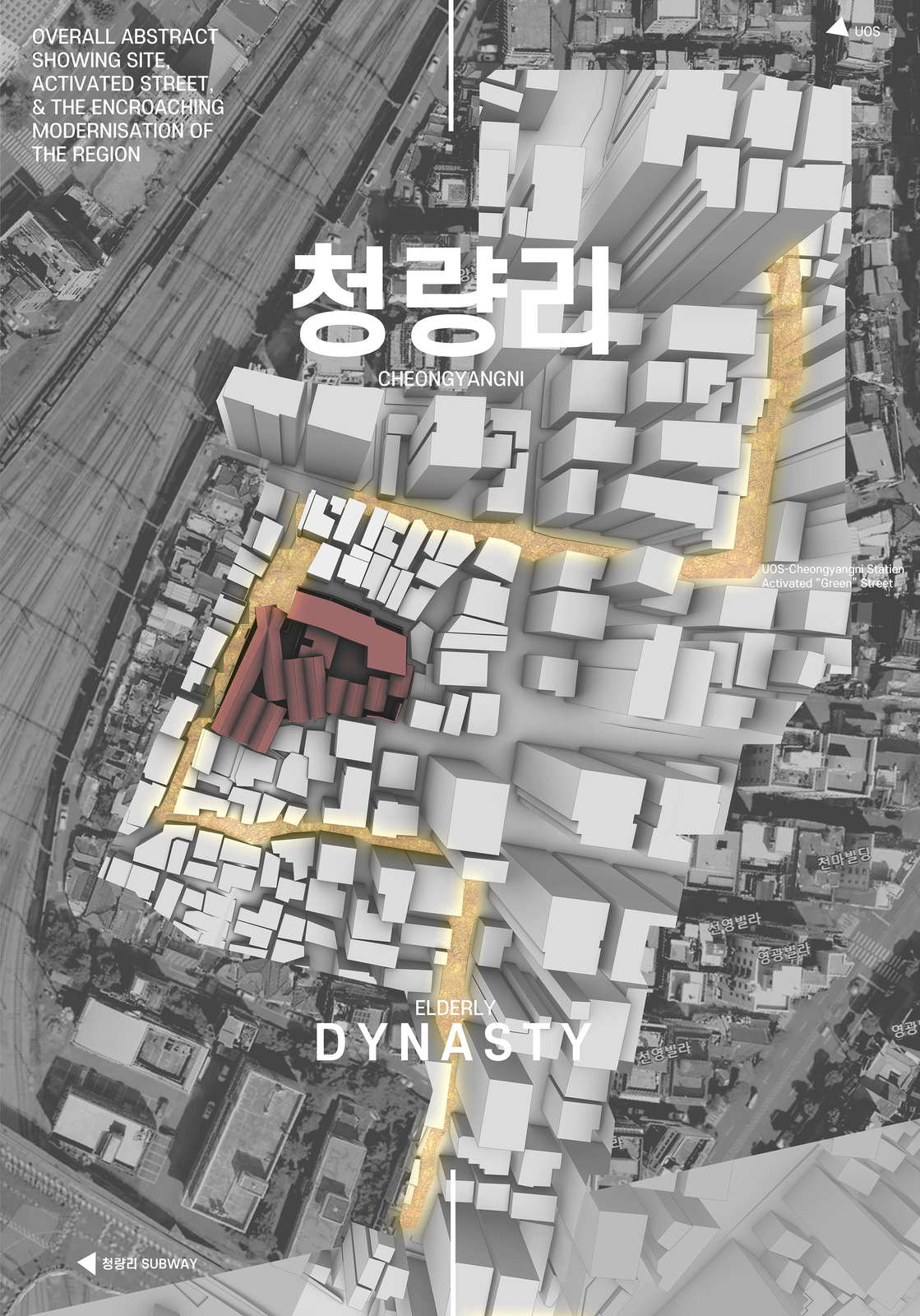


CHEONGNYANGNI 청량리 DYNASTY // THE LAST ELDERLY DYNASTY 마지막 고대 왕조
Project Intention _ // 프로젝트 의도 _
The project intends to combine the programmes of elderly outpatient care, a small temporary nursing home, as well as a training facility for UOS's department of social welfare in order to do act as a midway point for the elderly who will have to leave the Cheongnyangni region as korean Capitalists begin to redevelop their original homes into towering skyscrapers for commercial and business use.
이 프로젝트는 청량리 지역을 떠나야 하는 노인들에게 중간 지점 역할을 하기 위해 UOS의 사회 복지과 훈련 시설과 소규모 임시 양로원인 노인 외래 진료 프로그램을 결합하는 것입니다. 한국 자본가들이 원래 집을 상업 및 업무용으로 우뚝 솟은 고층 건물로 재개발하기 시작하면서.
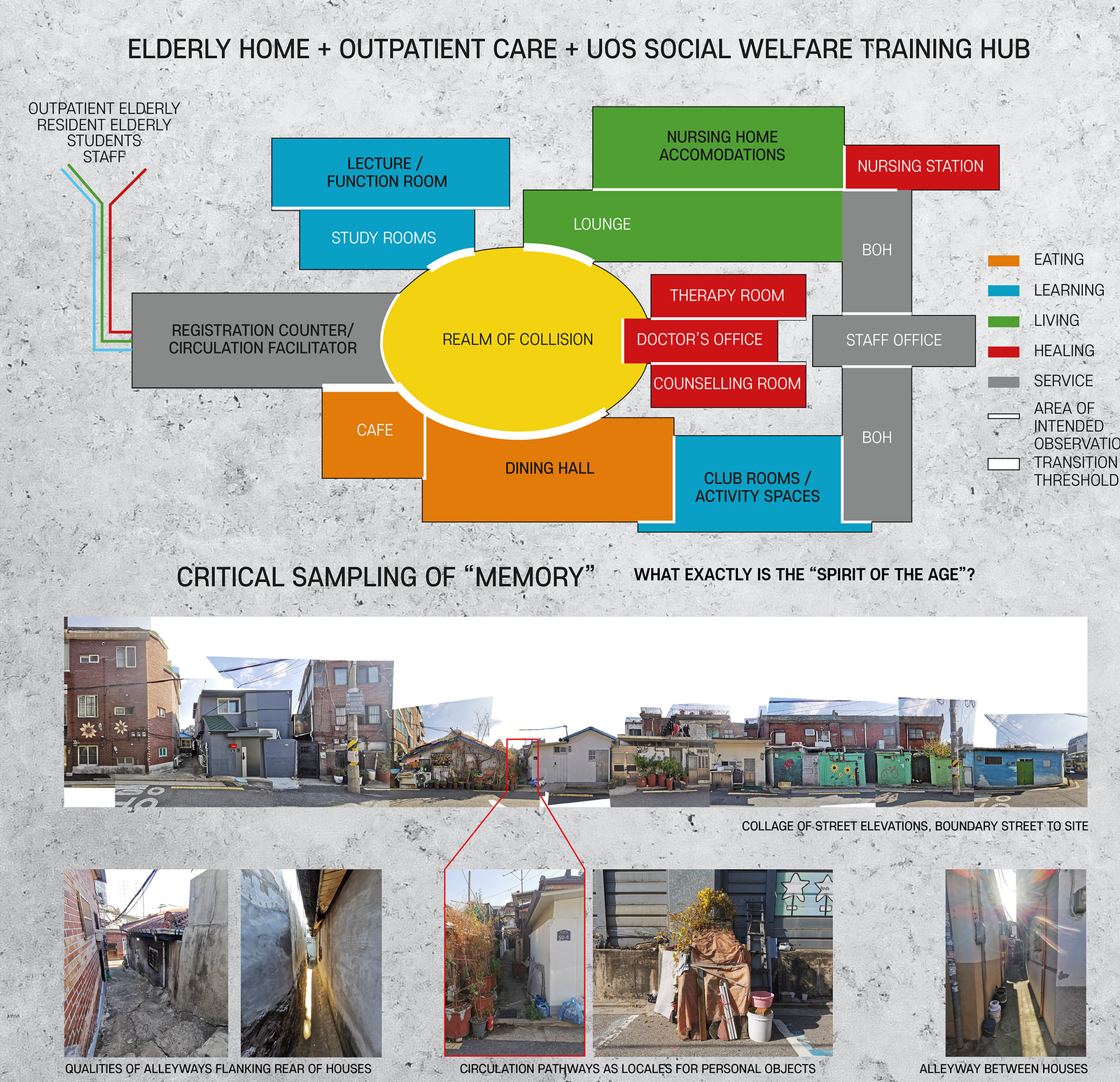
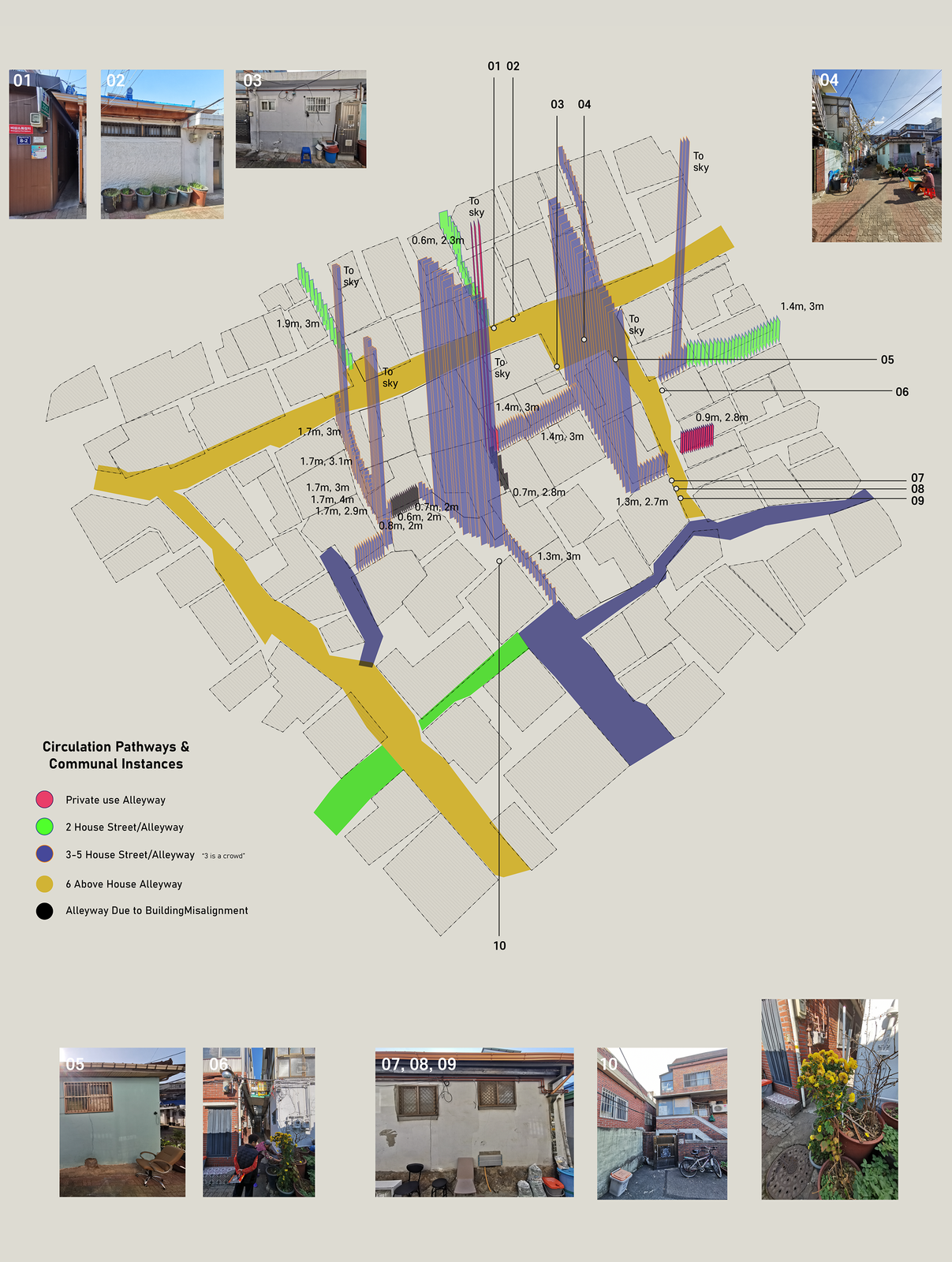
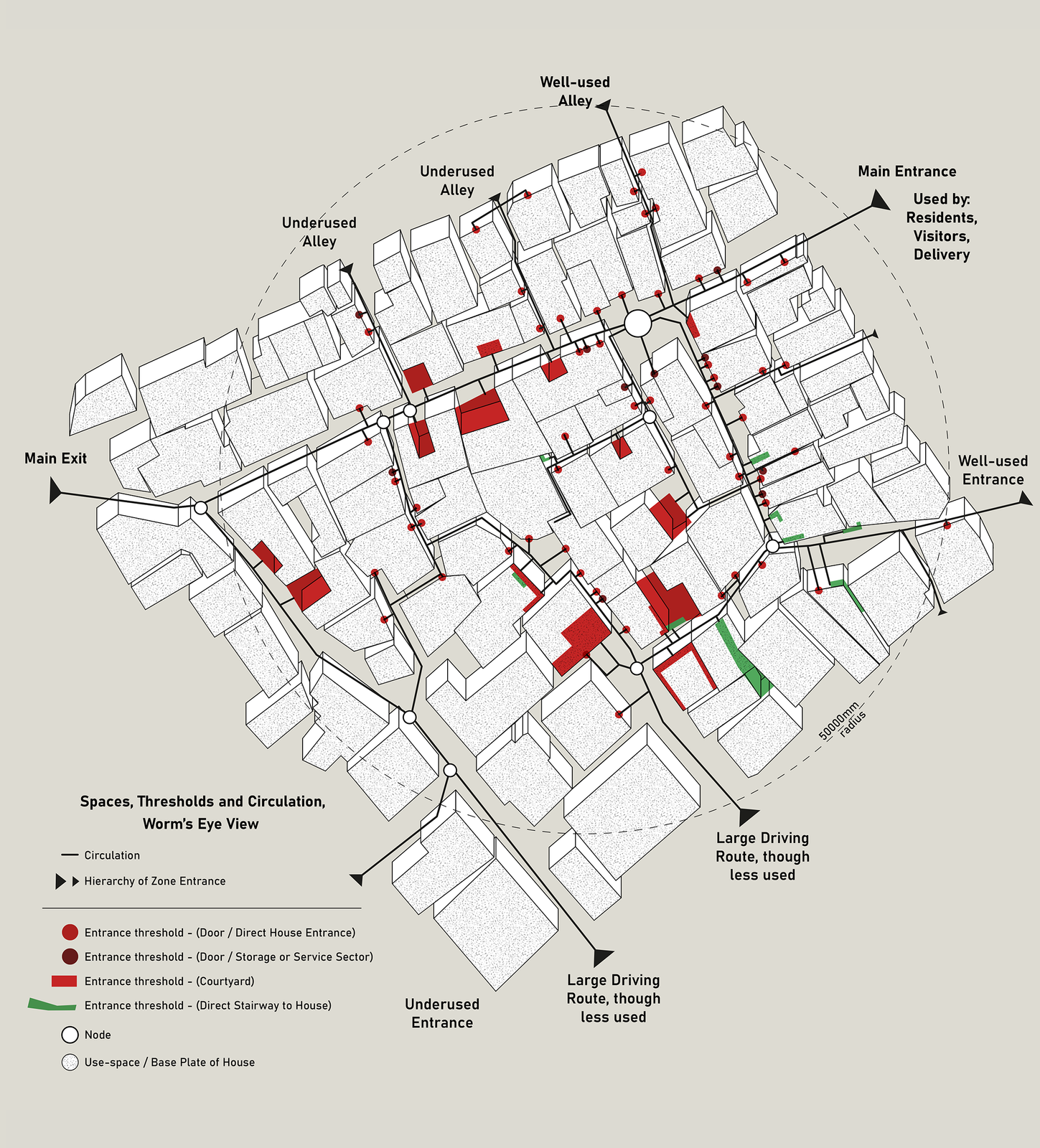
Site Analysis _ // 사이트 분석 _
The analysis of the site tells us a unique story of memory in cheongyangni's elderly. The buildings form an indisputable moment in Korean history where a lack of government standardisation enabled the citizens to build as they so desired, and the traditional Korean Hanok evolved into something in between the lines of traditional, modern and terribly made due to the low budget that the poor had. The building mentality of the people at the time leads to the rise of many unexpected alleyways and a tremendous amount of unstandardised entrances into the user-spaces. Often times, the paths of circulation are also communal spaces, because the housing typology doesn't allow for the people to commune in the home. The building therefore attempts to evoke the memory of the elderly by colonising the perimeter walls of 16 unique houses in the site, while giving its programme the winding complexity of the original townscape.
현장 분석은 청양리 어르신들의 독특한 기억 이야기를 들려준다. 건물은 정부의 표준화 부족으로 시민들이 원하는대로 지을 수 있었던 한국 역사의 명백한 순간을 형성하고, 한국 전통 한옥은 저예산으로 인해 전통, 현대 및 끔찍한 라인 사이에서 진화했습니다. 가난한 사람들은 가지고 있었다. 당시 건물의 건축 사고방식은 많은 예상치 못한 골목길의 증가와 사용자 공간으로의 엄청난 양의 표준화되지 않은 입구로 이어졌습니다. 종종 동선의 경로는 공동의 공간이기도 합니다. 주택 유형은 사람들이 집에서 교감하는 것을 허용하지 않기 때문입니다. 따라서 건물은 원래 도시 풍경의 구불구불한 복잡성을 프로그램에 제공하면서 부지에 있는 16개의 독특한 주택의 주변 벽을 식민지화하여 노인들의 기억을 불러일으키려고 시도합니다.
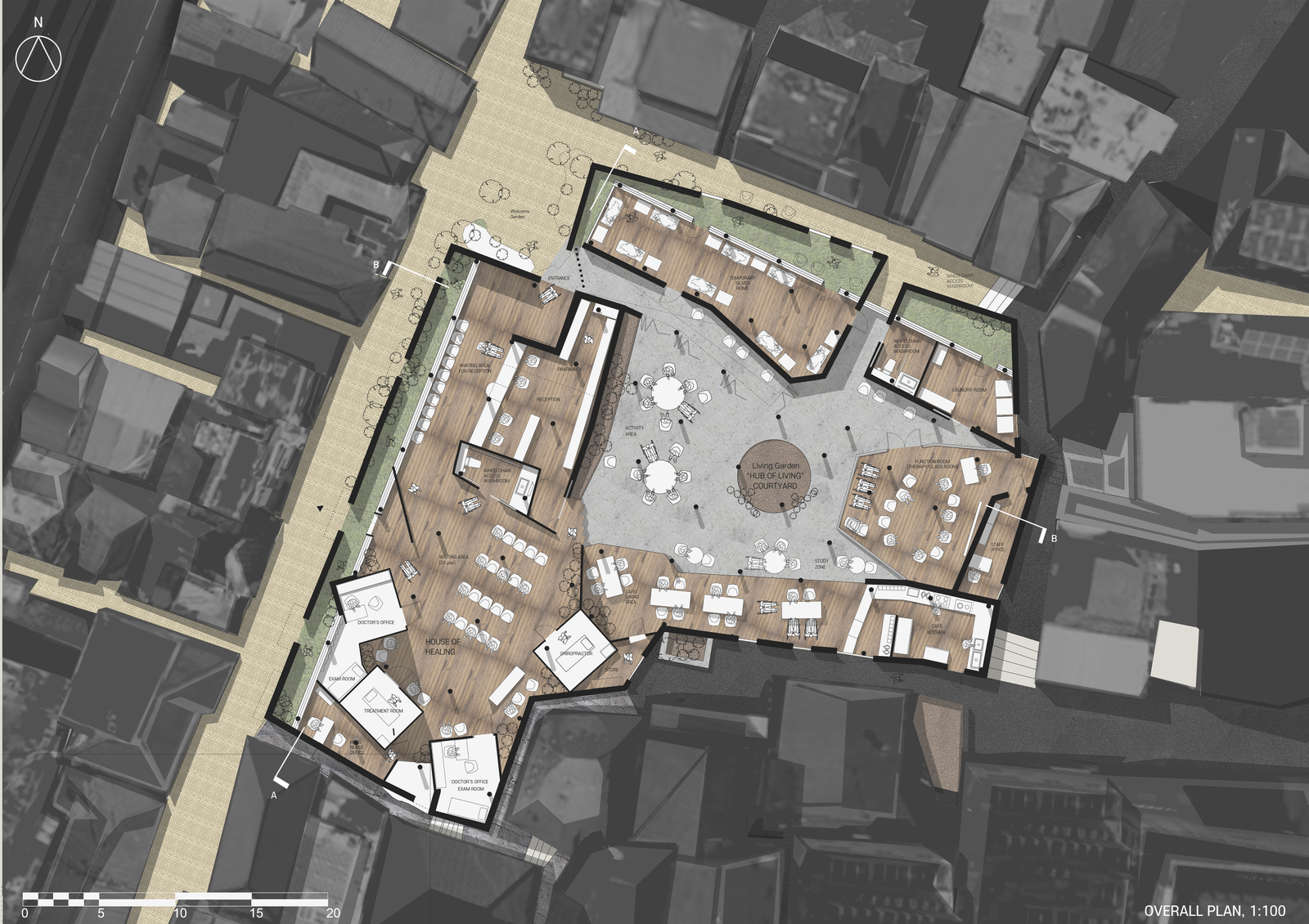
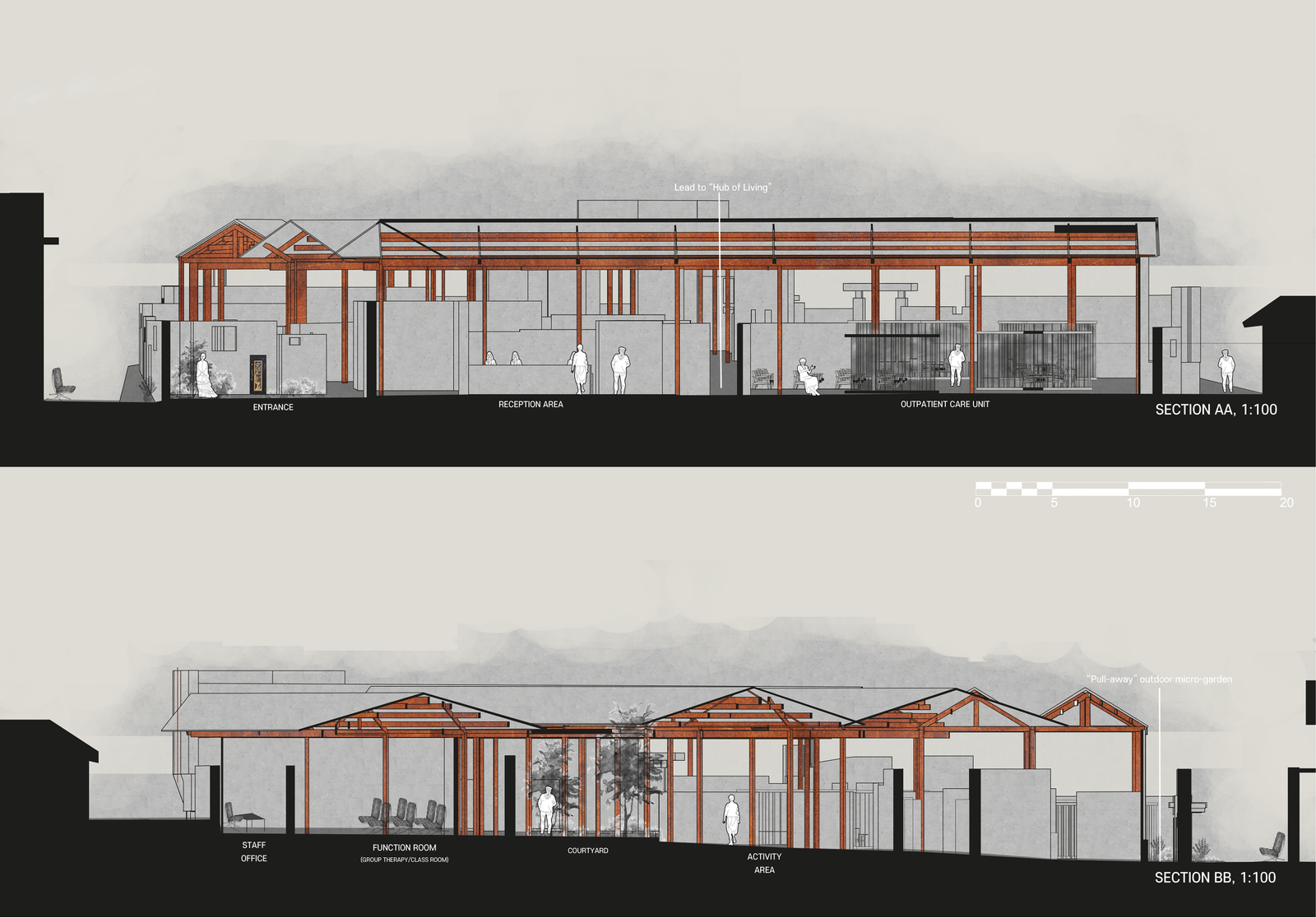
Plan & Program _ // 계획 및 프로그램 _
The building is divided into 4 clear segments - the outpatient clinic, the dining hall, the learning hall, and the resident home.
In the outpatient clinic, the logic is to have the architecture control and guide the visitor, because the elderly are old and need some form of cognitive and visual aid to help them achieve their task of visiting the correct order of treatment, whilst the other spaces do not require such a controlling form of architecture. Instead, the rest of the building exists as a large open space in which can freely experience the different processes of living life.
건물은 외래진료실, 식당, 학습실, 거주인의 집 등 4개의 명확한 부분으로 나뉩니다.
외래진료소의 논리는 건축물이 방문자를 통제하고 안내하는 것입니다. 이러한 제어 형식의 아키텍처가 필요하지 않습니다. 대신 건물의 나머지 부분은 다양한 삶의 과정을 자유롭게 경험할 수 있는 커다란 열린 공간으로 존재한다.
The outpatient clinic consists of a circulation that is strict in terms of its sequence. The entrance of the site repurposes the 10mx10m public gathering area of the site to form the new entrance of the building, that subsequently leads the visitor into the reception hall, and a large atrium that redirects the view of the visitors to the different treatment units that pop up and break free from the walls, in turn creating interesting crevice spaces that can be populated with servant programmes like store rooms, an evacuation corner, nursing office and even some reading corners for students. The dining hall consists of tables that are used by both visitors, students, staff and the elderly, and is served by a small kitchen that repurposes the ground plan of a small terrace house of the site. The learning hall consists of the students study zone, the elderly's activity area, and a large glass function room and teacher's office that surrounds a 5m diameter courtyard. The resident home consists of the home itself and the servant spaces needed to run the whole programme, which are the bathroom and laundry room. In order to re-trigger the elderly's original experience of community in this site, the building also incorporates a short segment of an indoor alleyway that buffers between the home and the rest of the atrium to simulate the way they approach the atrium of activities.
외래 진료는 순서가 엄격한 순환으로 구성되어 있습니다. 사이트의 입구는 사이트의 10mx10m 공공 모임 영역을 용도 변경하여 건물의 새로운 입구를 형성하고 방문자를 리셉션 홀로 안내하고 방문자의 시야를 다른 치료 장치로 리디렉션하는 대형 아트리움을 형성합니다. 튀어나와 벽에서 벗어나서 창고, 대피 코너, 양호실, 심지어 학생들을 위한 일부 독서 코너와 같은 서번트 프로그램으로 채워질 수 있는 흥미로운 틈 공간을 만듭니다. 식당은 방문자, 학생, 직원 및 노인 모두가 사용하는 테이블로 구성되어 있으며 부지의 작은 테라스 하우스의 평면도를 용도 변경한 작은 주방이 제공됩니다. 학습 홀은 학생 학습 구역, 노인 활동 구역, 직경 5m의 안뜰을 둘러싸고 있는 대형 유리 기능실 및 교사 사무실로 구성됩니다. 거주자 주택은 주택 자체와 전체 프로그램을 실행하는 데 필요한 하인 공간인 욕실과 세탁실로 구성됩니다. 이 부지에서 노인들의 원래 공동체 경험을 다시 촉발시키기 위해 건물은 또한 그들이 활동의 아트리움에 접근하는 방식을 시뮬레이션하기 위해 집과 아트리움의 나머지 부분 사이를 완충하는 실내 골목길의 짧은 부분을 통합합니다.

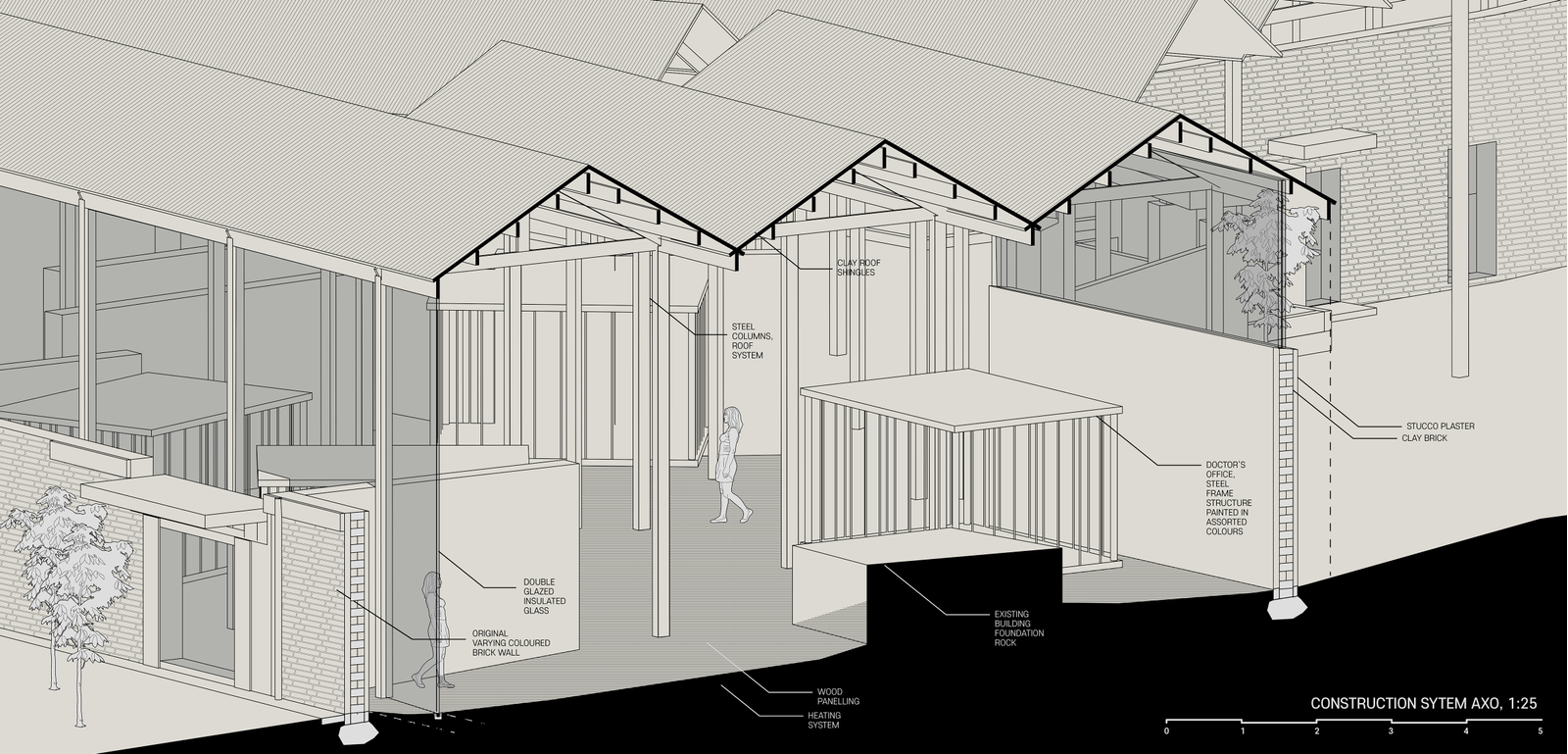
Tectonic Features _ // 구조적 특징 _
The structure of the building is simple. The existing perimeter walls are repurposed, and a steel gable roof structure descends upon it. But, because the original walls are not structural, insulation comes in the form of a glass system surrounding the perimeter of the roof structure. The internal glass facade also pulls away from the original walls to the northeast and northwest, in order to generate an interesting interplay of greenery and the outdoors, which the elderly absolutely need for mental stimulation.
건물 구조는 단순하다. 기존 주변 벽은 용도가 변경되고 강철 박공 지붕 구조가 그 위에 내려옵니다. 그러나 원래 벽은 구조적이지 않기 때문에 단열은 지붕 구조 주변을 둘러싸는 유리 시스템의 형태로 이루어집니다. 내부 유리 파사드는 노인들이 정신적 자극을 위해 절대적으로 필요로 하는 녹지와 야외의 흥미로운 상호 작용을 생성하기 위해 원래 벽에서 북동쪽과 북서쪽으로 당겨집니다.
Finally, the key feature that arises due to the structure of the building is that because the internal walls never touch the ceiling, the sounds from the different rooms are in constant flux. This causes the building to mimic the mentally stimulating environment that the elderly identify as peaceful in today's diminishing Cheongyangni Dynasty.
마지막으로 건물의 구조로 인해 발생하는 주요 특징은 내부 벽이 천장에 닿지 않기 때문에 다른 방의 소리가 지속적으로 흐르고 있다는 것입니다. 이로 인해 건물은 오늘날 쇠퇴하는 청량리 시대에 노인들이 평화롭다고 여기는 정신적 자극 환경을 모방합니다.
Copyright © uosarch.ac.kr., Some rights reserved.